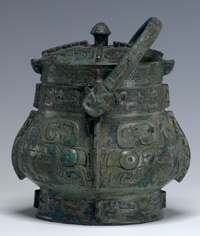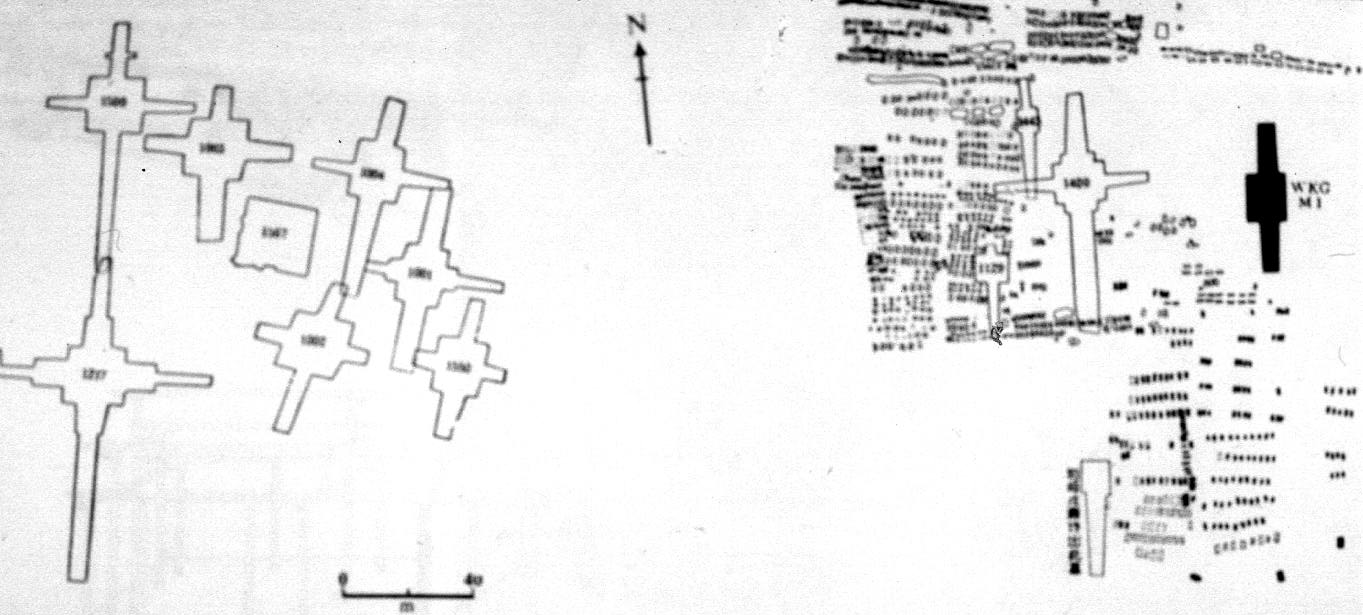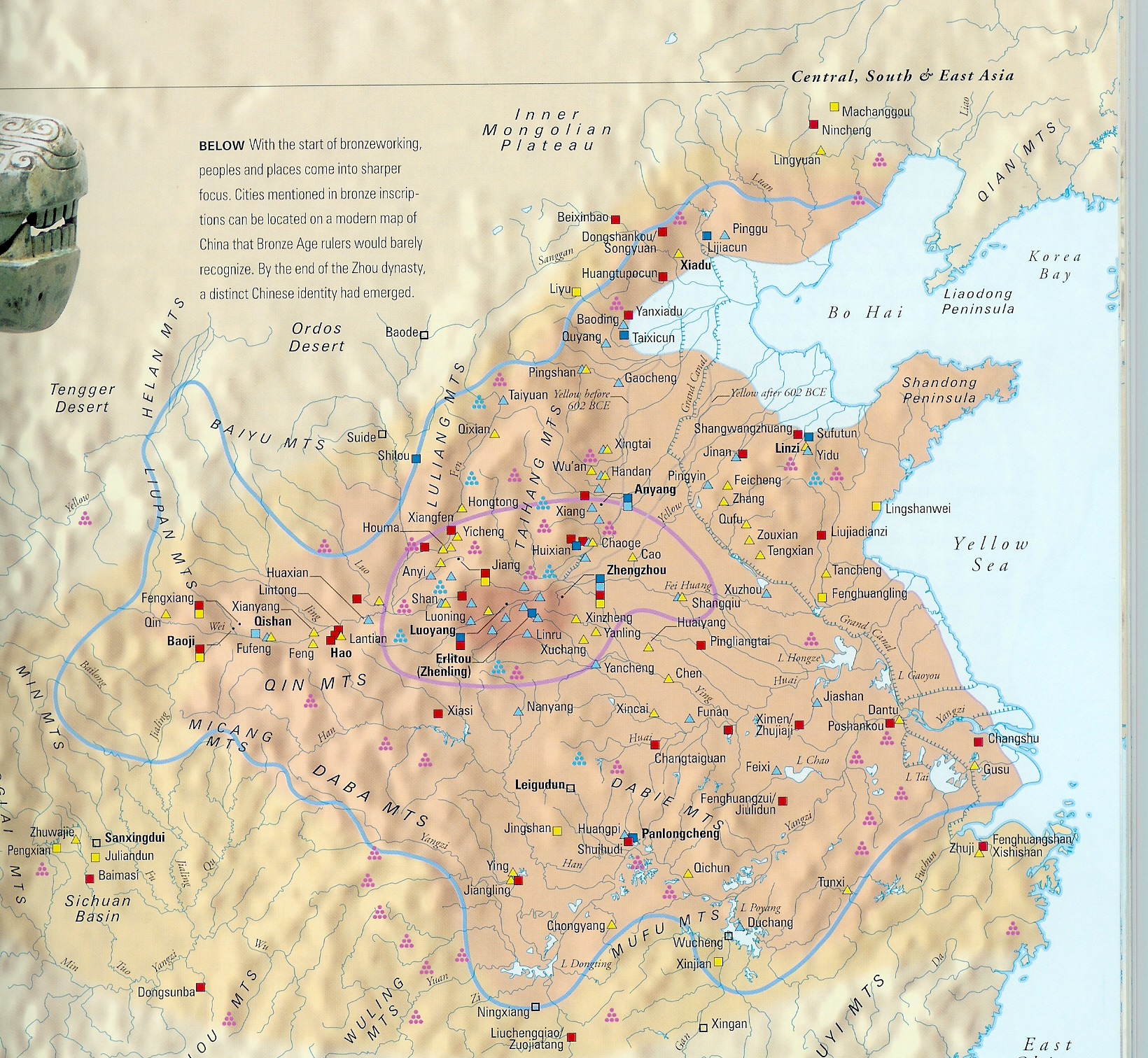Keynotes 4
Chinese
Dynastic History
The Xia - Dynasty (2205-1766 BCE)
The Xia was long
considered to be a mythical dynasty but since archaeological excavations in
Erlitou, south of the Yellow River have been conducted and their finds dated,
the historicity of the dynasty becomes more likely than ever. Perhaps the Xia developed the famous black pottery. They made the earliest
attempts to cast bronze and created the earliest characters of the Chinese writing
system. According to the archaeological evidence the Xia were
located in southern Shanxi and western Henan.
Some scholars are convinced that a matriarchal
system was prevalent in pre-dynastic China because recorded Clan names start with the
character for woman.
The Spring and Autumn Annals of Master Lü (Lü shi chunqiu), a
source from the 3rd cent. BCE reports that “people lived in groups.
One knew the mother but not the father; there were no separate families.”
The Shang - Dynasty (1766-1050 BCE)/ (1650-ca. 1050 BCE)
The Shang dynasty
was a city centered culture. Cities were walled, had public buildings, altars,
and were sites of aristocratic residences.
The Shang kings
had political, economic, social, and religious authority. They made offerings
to their ancestors who then interceded with the ‘Deity Above’ (Shangdi) on behalf of the king. This practice derived
from shamanistic rituals.
The Shang king’s
advisors created a calendar with months of 30 days and years of 360 days. The
calendar was important for conducting the rituals of the
seasons at the appropriate time and begin the agricultural works in
accordance with nature.
The military aristocracy of the Shang went to battle in war chariots. In warfare, prisoners
were enslaved: the least of the classes of Shang
society.
Inscriptions are transmitted on ritual
vessels made of bronze and on oracle bones. Both materials for inscriptions are
characteristic for the Shang.
Bronze appeared about 2000 B.C.E. in
China. (1000 years later than
in Mesopotamia and 500 years later than in
India). It was used for sacrificial vessels but
especially for weapons on which the aristocracy had a monopoly in order to have
control over their distribution.
 Shang gui
Shang gui
 Shang you
Shang you
Sacrificial vessels were used in the family
rituals performed in ancestor halls. Vessels found in tombs linked the ritual
to the realm of the netherworld. They were also regalia of political power.
Therefore one finds vessels from different periods in tombs. The amount of vessels
that were found in tombs mirrors the status of the
deceased. The vessels can be of different quality, pattern and size.
Bronze was of exceptional value and the
successful casting of bronze difficult. The Chinese artisans used an elaborate
modular technique which is unique among civilizations using bronze. While in
other cultures bronze was cast with the lost-wax-method (with a mold that was
destroyed in the end of the process) in China bronzes were cast with molds that could be
reused in order to be able to produce bronzes with the same pattern repeatedly
and in sets.
The artisans formed negative clay molds
constructed of several pieces. The pattern appeared in the negative of the mold.
They placed a core into the negative mantle and poured the liquid bronze into
the space between the mantle and the core. The parts of the molds were
composite, interchangeable parts combined into units.
Patterns were zoomorphic or abstract and
arranged in registers and compartments on the vessel. This facilitated the
production of the mould for the artisan and the identification of the status of
the owner by other members of the nobility.
The production of sacrificial vessels was a
highly organized process which required labor division. Division of labor favors
uniformity which in the Shang was characterized by a
high level of quality. There must have been a system of work coordination and
supervision in order to make sure that quality standards were
kept.
The
Excavation of the Ruins of Yin:
(Yin is sometimes used as a synonym for the Shang
dynasty.)
1909
1920
'wild', unofficial excavations
1924/25
1928: Founding of the Academia Sinica, the National Academy of Sciences of
China. The Harvard educated archaeologist Li
Ji (1895-1979) was entrusted with the
excavations at Anyang (1928-1937).
In these excavations the archives of the
department of the divination of the Shang court were
discovered. They contained thousands of oracle bones which were incised with
archaic Chinese characters. The names of the kings could now be compared with
the names mentioned in later historical records.
11 tombs of kings were found, among them
the tomb of Fu Hao, a Shang queen,
the only tomb that had not been plundered. The tombs reveal that human sacrifices
were common in the Shang: Hundreds of slaves, prisoners
of war, and servants of the king were buried with him to serve him in the afterlife.
 Shang cemetery in Anyang
Shang cemetery in Anyang
 Tomb of a Shang king
Tomb of a Shang king
Next to sacrificial vessels oracle bones
were found. But the first oracle bones had become objects of study before the
systematic excavation of the Ruins of Yin and their academic analysis:
1899: Liu E (1857-1909) visited his sick friend,
Wang Yirong (1845-1900) who needed a remedy against
Malaria attacks. They bought tortoise shells at a traditional pharmacy in Beijing. When pounded into a fine powder according
to traditional Chinese medicine the shells could be used as a remedy recommended
to cure malaria.
The friends discovered characters that have
been incised into the shell. They inquired where the apothecary had bought the
shells and then Liu bought as many shells as he could collect from peasants
around the city of Anyang. He copied the characters on the shells
and finally published his collection in
order to enable philologists to decipher the mysterious messages which later
were donfirmed to be records of divination processes.

Map of the three earliest
Chinese dynasties: Xia, Shang, and Zhou
The purple circle shows the core area of the Xia, the blue line encircles the
maximum extends of the Shang dynasty. The dark brown area indicates the heartland
of the Zhou dynasty, the lighter brown shows the extents of the Zhou, the yellow
area shows the Chinese cultural influence by the 5th century BCE.
(Paul G. Bahn, The
Atlas of World Archaeology. Oxford: Checkmark Books 2000, 117).
 Shang gui
Shang gui Shang gui
Shang gui Shang you
Shang you
 Tomb of a Shang king
Tomb of a Shang king 